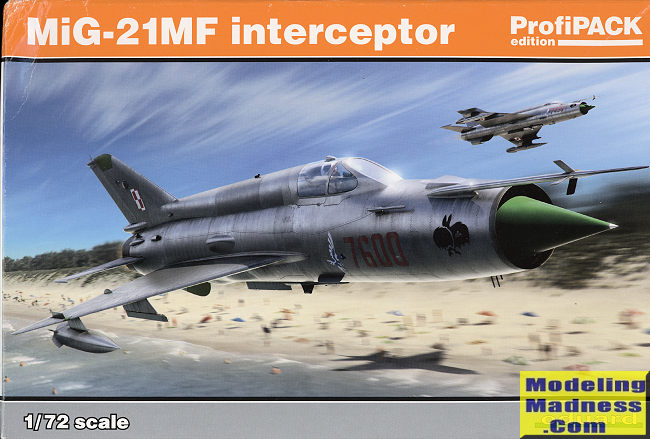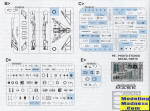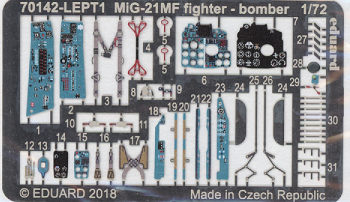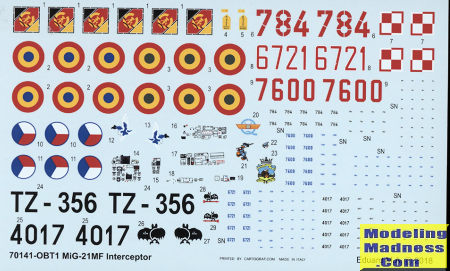
Eduard 1/72 MiG-21MF 'Interceptor'
| KIT #: | 70141 |
| PRICE: | $24.95 plus shipping |
| DECALS: | Five options |
| REVIEWER: | Scott Van Aken |
| NOTES: | Profipack |

| HISTORY |
The Mikoyan-Gurevich MiG-21 (Russian: Микоян и Гуревич МиГ-21; NATO reporting name "Fishbed") is a supersonic jet fighter aircraft, designed by the Mikoyan-Gurevich Design Bureau in the Soviet Union. It was popularly nicknamed "balalaika", from the aircraft's planform-view resemblance to the Russian stringed musical instrument or ołówek (English: pencil) by Polish pilots due to the shape of its fuselage. Early versions are considered second-generation jet fighters, while later versions are considered to be third-generation jet fighters. Some 50 countries over four continents have flown the MiG-21, and it still serves many nations a half-century after its maiden flight. The fighter made aviation records. At least by name, it is the most-produced supersonic jet aircraft in aviation history (nearly 11,500 examples according to some sources) and the most-produced combat aircraft since the Korean War. It also had the longest production run of a combat aircraft (1959 to 1985 over all variants).
Because of all the conflicts in which it has been involved, some wags say it is the most shot down supersonic aircraft in history. While your editor thinks that may be more true for the F-4 or F-105 due to the intense ground fire in Vietnam, it may be that the MiG-21 has been shot down in air to air combat more than any other supersonic jet.
The MiG-21MF is a third generation version of the aircraft. It is an export version of the MiG-21SM, with RP-22 radar and R13-300 turbojet. The choice of weapons loads was increased with the addition of the R-60 (NATO: AA-8 "Aphid") and later the R-60M IR-seeking AAM. These were also licence-built in India by HAL as the Type 88.
| THE KIT |
 Having pretty
well covered 1/48 with the MiG-21 family as well as a series in 1/144, Eduard
finally decided to cover 1/72 scale. The wait has been worth it. Typical of
Eduard, the molding is quite good with a number of parts not used in this
boxing.
Having pretty
well covered 1/48 with the MiG-21 family as well as a series in 1/144, Eduard
finally decided to cover 1/72 scale. The wait has been worth it. Typical of
Eduard, the molding is quite good with a number of parts not used in this
boxing.
Having a separate upper spine with fin will allow pretty much all the sprues to be used with earlier and later versions, changing out very few other parts in the process. While this does make for more economical use of sprues, it adds to the 'fiddliness' of the kit, a trait rather common with Eduard releases. Note that this kit is identical to the previously previewed version save for the markings options. Though the kit's p.e. fret has a different number, the items on it are the same so I've used the previous illustration.
Since this is a Profipack release, it comes
with a nice color photo etch set, much of what is used in the cockpit in terms
of instrument panels and you are provided a 'blank' when using the p.e.
Otherwise, you can use the raised detail plastic parts and put decals atop them.
 For those
who don't like p.e., this would be a good option as would waiting for the
weekend editions which won't have photo etch.
For those
who don't like p.e., this would be a good option as would waiting for the
weekend editions which won't have photo etch.
There is no 'tub' for the cockpit with the side walls and bulkheads being added. The nose gear well is part of the cockpit assembly and needs the side walls attached. There is a diagram that shows all these bits in place so you can be sure you have it properly aligned. The main gear well is also four pieces and you build up that as well as the five piece exhaust before assembling the fuselage halves. When you do assemble the halves, you'll find that it comes with a separate ring inside the intake so you can paint and install the radome at the end of the construction process when the airframe is painted.
The lower wing is one piece and includes the lower fuselage. Before attaching the upper wing halves, you are to install the landing lights along with a number of other clear bits that are to be painted various colors. Masking these will not be all that easy and frankly, these are something I've not seen before. Then the wing and spine/fin are attached along with the windscreen and intake ring. The various small engine scoops and the tailplanes are then glued on.
Even though the flaps and ailerons are separate, these were rarely deflected when the plane was on the ground so positioning them up is the norm. You are provided with two flap options that are the same save for one additional panel line on one set. Wheel hubs are separate from the tire on both the nose and main tire. Gear is very nicely molded with separate oleo scissors and brake lines.
The forward speed brakes are molded closed, but you can pose the aft one lowered. You are provided with a pair of rocket take off units if you wish to add them. It isn't until near the end of the build that Eduard has you assemble the seat and there are quite a few p.e. bits for the seat harness. The canopy can be posed open or closed and there are tabs for the open option that have to be cut off for the closed canopy. There are tiny little p.e. bits for the nose pitot probe.
Lots of things for under wings with two
different styles of fuel tanks and a nice collection of missiles and rocket
pods. I would have thought perhaps some iron bombs would have been nice for the
fighter-bomber boxing, but that was not to be. All of the various pylons are
butt joined.
Instructions are well done with Gunze and Mission Models paint references. Five options are provided including light grey versions from Poland, Czechoslovakia, and Romania. This grey needs to be mixed using the paints provided, but I'll bet there is a ready to go paint done by someone else. There is an East German aircraft in dark green and olive drab and a plane from Mali in tan, sand, dark green and bright green. The printing of the insignia is such that, unless you have a very strong light, you cannot tell that the center is green, so it is easy to mistake it for the Romanian insignia. Aside from that, the decals are well printed and provide a ton of stencils in both blue and black. The stencil sheet is huge and not shown, but also includes stencils for all the weapons. Those who include all of these will spend as much time on decals as building the kit. If you don't like any of the markings options, there are aftermarket sheets for this aircraft. Also in this boxing are masks for the canopy and various antennas.

| CONCLUSIONS |
| REFERENCES |
http://en.wikipedia.org/wiki/MiG-21#Variants
November 2018
Copyright ModelingMadness.com. All rights reserved.
If you would like your product reviewed fairly and fairly quickly, please contact the editor or see other details in the Note to Contributors.